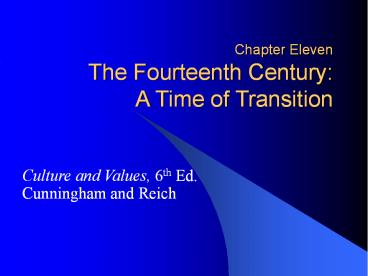Chapter Eleven The Fourteenth Century: A Time of Transition - PowerPoint PPT Presentation
1 / 34
Title:
Chapter Eleven The Fourteenth Century: A Time of Transition
Description:
Chapter Eleven The Fourteenth Century: A Time of Transition Culture and Values, 6th Ed. Cunningham and Reich Calamity, Decay, and Violence: The Black Death 1348 ... – PowerPoint PPT presentation
Number of Views:401
Avg rating:3.0/5.0
Title: Chapter Eleven The Fourteenth Century: A Time of Transition
1
Chapter ElevenThe Fourteenth Century A Time of
Transition
- Culture and Values, 6th Ed.
- Cunningham and Reich
2
(No Transcript)
3
Calamity, Decay, and Violence The Black Death
- 1348 Bubonic Plague Epidemic
- Population decline
- Boccaccios Decameron
- Eyewitness to the plague
- Fabliaux, exempla, romances
- Human Comedy vs. Divine Comedy
4
Calamity, Decay, and ViolenceThe Great Schism
- Boniface VIII vs. Philip the Fair of France
- Avignon Papacy / Babylonian Captivity
- 1378, three rival claimants to the papacy
- Church reform
- Peasant Revolt of 1381
- Robin Hood myth
5
Calamity, Decay, and ViolenceThe Hundred Years
War
- Conflict between France and England
- Fought on French soil
- Poitiers, Crécy, Agincourt
- Pillaging bands of mercenaries
- Introduction of the longbow
6
Literature in Italy, England, and
FrancePetrarch (1304-1374)
- From Tuscany, South Florence
- Restless and curious
- Collected and copied ancient texts
- Poet Laureate of Rome - 1348
- Renaissance sensibility
- Keen interest in self
- Desire for personal glory and fame
- Secretum
7
Literature in Italy, England, and
FrancePetrarch (1304-1374)
- Letter to Posterity
- Augustines Confessions
- Latin writings, Latin masters
- Vernacular Poetry
- Canzoniere sonnets, canzoni
- Inspired by Laura
- Petrarchism
8
Literature in Italy, England, and
FranceGeoffrey Chaucer (1340-1400)
- Highly placed civil servant
- Poetry, translations, treatise of the astrolabe
- English language as literary vehicle
- Skill in the art of human observation
- Canterbury Tales
- Narrative frame
- Cross-section of medieval society
- Social commentary
9
Literature in Italy, England, and
FranceChristine de Pisan (1365-1428?)
- First female professional writer
- Literary debate Romance of the Rose
- Attacked Jean de Meungs misogyny
- A Letter to the God of Love
- The Book of the City of Ladies
- The Treasure of the City of Ladies
- The Book of Peace
10
Art in ItalyThe Italo-Byzantine Background
- Northern artists inspired by classical art
- France, England, Germany
- Italian artists rooted in Byzantine style
- Conservative, traditional
- Italian sculptors broke from tradition
- Nicola Pisano emphasis on classical models
- Giovanni Pisano N. European influence
11
(No Transcript)
12
(No Transcript)
13
Art in ItalyThe Italo-Byzantine Background
- Cimabue (1240?-1302?)
- Realism, anatomical understanding
- Emotional appeal corporeal weight and strain
- Sense of space
- Duccio di Buoninsegna (1255?-1319?)
- Emotional states of subjects through their
physical appearances - Greater sense of space
14
(No Transcript)
15
(No Transcript)
16
(No Transcript)
17
Art in ItalyGiottos Break with the Past
- Giotto da Bondone (1266?-1337)
- Revolutionary figure (Vasari)
- Realism
- Depth, volume through use of light and dark
- Three-dimensional modeling of figures
- imitate nature
- Naturalistic style
- Emotion and drama
18
(No Transcript)
19
Art in ItalyPainting in Siena
- International Style
- Simone Martini (c. 1285-1344)
- vs. Giottos solid realism
- Grace, sophistication, splendor, elegance
- Application of Giottos Realsim
- Pietro and Ambrogio Lorenzetti (d. 1348)
- Palazzo Pubblico fresco
20
(No Transcript)
21
Art in Northern Europe
- Artistic language International Style
- Reciprocity of style (Italy, Northern Europe)
- Wilton Diptych
- Court of the Duke of Burgundy, Dijon
- Claus Sluters Well of Moses
- Limbourg brothers, Trés Riches Heures
22
(No Transcript)
23
(No Transcript)
24
(No Transcript)
25
(No Transcript)
26
Late Gothic Architecture
- Florence Cathedral
- Brunelleschis dome
- Duomo in Milan
- Blend of Gothic and Classical elements
- Secular public buildings
- Palazzo Vecchio, Palazzo Pubblico
- Doges Palace in Venice
- Englands Perpendicular style
27
(No Transcript)
28
(No Transcript)
29
(No Transcript)
30
Music Ars Nova
- Independent, secular musicians
- Ballads, love songs, current events
- Ars Nova
- Philippe de Vitry (1291-1361)
- Richness and complexity of sound
- Harmonies, isorhythm
31
(No Transcript)
32
Music Guillaume de Machaut (1304?-1377)
- Messe de Notre Dame
- Kyrie Eleison
- Gloria
- Credo
- Sanctus and Benedictus
- Agnus Dei
- Secular music
- Ballades, troubadour songs
33
Music Francesco Landini (1325-1397)
- Blind virtuoso performer
- Organ, lute, flute
- Madrigals
- Ballate
- Musica ficta, notational problems
34
Chapter Eleven Discussion Questions
- In what ways do Petrarchs life and work
illustrate the conflict between medieval and
Renaissance ideals? Explain. - According to the text, Chaucer is still very
much a medieval man. Explain Chaucers ties to
medieval culture do you agree that his ideology
is completely medieval or are there signs of the
emerging Renaissance within his Canterbury Tales? - What characteristics are typical of the
Italo-Byzantine style? What did early Renaissance
artists do to break from this tradition? Explain,
citing specific artistic examples. - Compare the Madonna Enthroned as painted by
Cimabue, Duccio, and Giotto. What stylistic
influences, growth, and changes can be traced
through the treatment of this theme by each
artist? - Although the term Ars Nova was originally applied
to music of the period, is it possible to apply
the term to the visual arts that emerged during
the early Renaissance? Explain.































